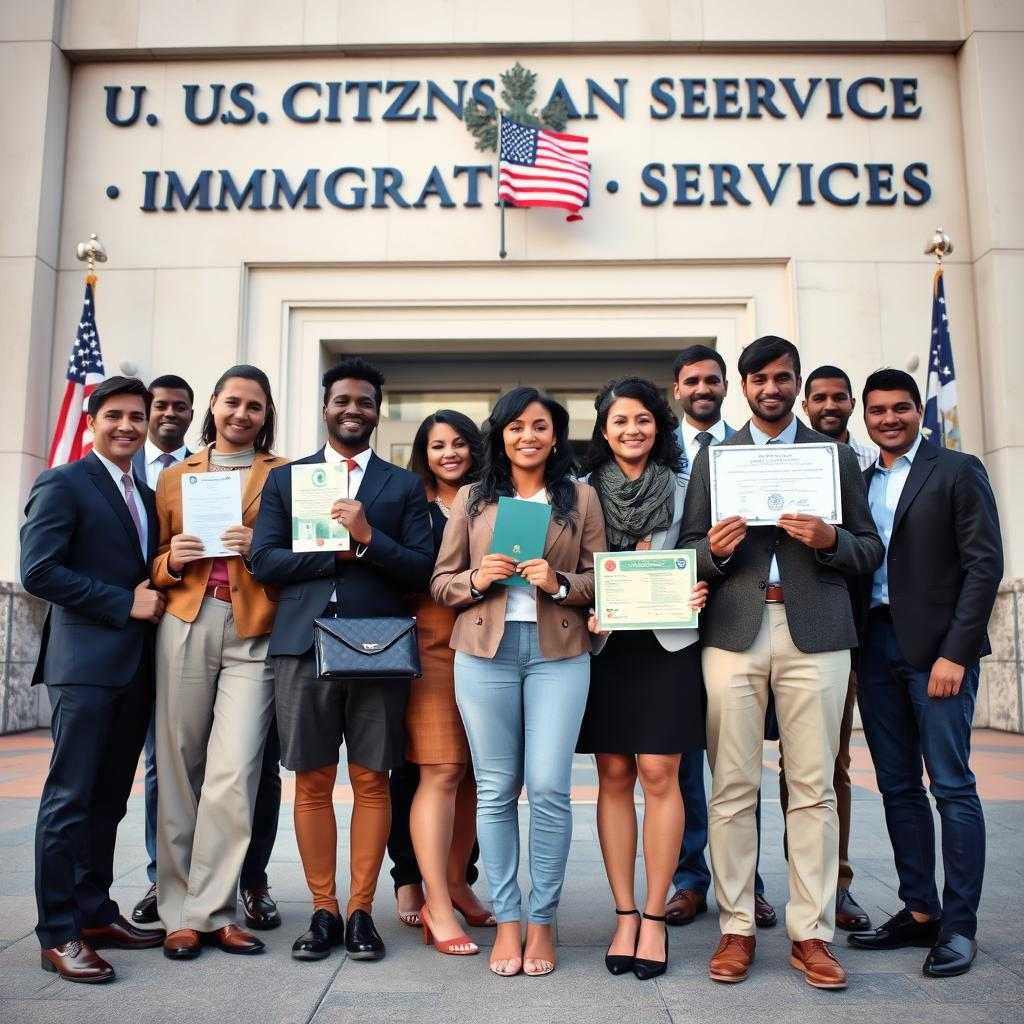For many immigrants, receiving a Green Card is a major milestone—but it’s only the first step on the journey to fully participating in American civic life. If you’ve achieved lawful permanent residency, you might be wondering how to take the next step and apply for U.S. citizenship. In this guide, we break down the naturalization process, explain eligibility requirements, and provide a step-by-step roadmap to help you successfully file your Form N-400 with the United States Citizenship and Immigration Services (USCIS). Whether you’re planning ahead or ready to get started, this article will give you expert tips and actionable advice to transform your Green Card into a U.S. passport.

Table of Contents
Understanding the Path from Green Card to U.S. Citizenship
Transitioning from a Green Card holder to a U.S. citizen means entering the naturalization process. This process not only unlocks rights such as voting and running for office but also brings a deeper sense of belonging and security. Here’s what you need to know:
What Is Naturalization?
Naturalization is the legal process through which a non-U.S. citizen voluntarily becomes a U.S. citizen. To qualify, you must meet specific requirements set by law and prove that you are of good moral character, possess basic English skills, and have a solid understanding of U.S. history and government.
Eligibility Requirements
Before you apply, ensure you meet these basic criteria:
- Age: You must be at least 18 years old.
- Permanent Residency Duration: Generally, you need to have been a lawful permanent resident for at least 5 years—or 3 years if married to a U.S. citizen.
- Physical Presence: You must have physically lived in the U.S. for at least 30 months (2.5 years) out of the 5-year period (or 18 months if married to a U.S. citizen).
- Residency: You must have resided continuously in the USCIS district or state where you intend to apply for at least 3 months.
- Good Moral Character: You must demonstrate that you have maintained good moral character during the statutory period.
- English and Civics: You must pass tests covering basic English (reading, writing, and speaking) and U.S. civics.
- Oath of Allegiance: You must be willing to take the Oath of Allegiance to the United States.
For detailed eligibility guidelines, visit the USCIS Citizenship page.
Step-by-Step Guide to the Naturalization Process
Applying for U.S. citizenship involves several key steps. Follow our step-by-step guide to navigate the process with confidence:
1. Determine Your Eligibility
- Review Requirements: Confirm that you meet all the criteria—age, residency, physical presence, good moral character, and language/civics proficiency.
- Assess Special Circumstances: If you are married to a U.S. citizen, note that the residency requirement is reduced to 3 years. Use the USCIS Naturalization Eligibility Tool for a personalized assessment.
2. Prepare Your Form N-400
- Download or File Online: The application for naturalization is filed using Form N-400. You can download the form from USCIS’s official site or file it online by creating a free account on the USCIS website.
- Fill It Out Carefully: Provide accurate and complete information to avoid delays or denials.
3. Gather Supporting Documents
Prepare all required documents, which typically include:
- A copy of your Green Card (front and back)
- Evidence of continuous residence and physical presence (such as tax returns, employment records, lease agreements, or bank statements)
- Proof of marriage (if applying based on marriage to a U.S. citizen)
- Documents that demonstrate good moral character (e.g., court records, if applicable)
- Passport-style photos (if required)
4. Submit Your Application
- Filing Fee: Pay the required fee (check the current fee schedule on USCIS).
- Online Submission: If filing online, use the USCIS account to upload your completed Form N-400 and supporting documents.
- Mail Option: Alternatively, you can mail your application to the appropriate USCIS Lockbox facility.
5. Attend Your Biometrics Appointment
After your application is received, USCIS will schedule a biometrics appointment. During this appointment, you’ll provide:
- Fingerprints
- Photograph
- Signature
This step allows USCIS to conduct the necessary background checks.
6. Prepare for and Attend Your Naturalization Interview
- Study for the Test: USCIS will test your knowledge of U.S. civics and your ability to read, write, and speak basic English. Study materials and practice tests are available on the USCIS website.
- Interview Day: Bring your appointment notice, your Green Card, and any additional documents USCIS has requested. Answer the officer’s questions honestly and clearly.
7. Receive USCIS Decision
After the interview, USCIS will send you a notice with one of the following outcomes:
- Granted: Your application is approved.
- Continued: More evidence or a second interview is required.
- Denied: Your application is rejected (you may appeal or reapply after addressing the issues).
8. Take the Oath of Allegiance
If your application is approved, you will be scheduled for a naturalization ceremony where you will:
- Swear the Oath: This is the final step in becoming a U.S. citizen.
- Receive Your Certificate of Naturalization: This document proves your new status as a U.S. citizen.
9. Celebrate Your New U.S. Citizenship!
After taking the Oath, you are officially a U.S. citizen. Enjoy the new rights and responsibilities that come with your citizenship.
Tips for a Successful Naturalization Application
- Double-Check Your Documents: Incomplete or inaccurate paperwork can delay your application.
- Practice for the Test: Use USCIS study materials and consider joining a class or workshop.
- Keep Records Organized: Maintain copies of all submitted documents and correspondence.
- Seek Professional Help: If you’re unsure about any step, consider consulting an immigration attorney or accredited representative. For further insights, check out our related article Green Card vs. U.S. Citizenship: Key Differences You Should Know
- Stay Informed: Immigration policies can change; regularly check the USCIS website for updates.
Frequently Asked Questions (FAQ)
Q1: How long must I wait after obtaining my Green Card to apply for U.S. citizenship?
A: Most lawful permanent residents must wait 5 years before applying, but if you are married to a U.S. citizen, you may be eligible after 3 years.
Q2: What form do I need to file for naturalization?
A: You must file Form N-400, Application for Naturalization. The form and instructions are available on the USCIS website.
Q3: What are the main eligibility requirements for naturalization?
A: You need to be at least 18 years old, have maintained continuous residence and physical presence, demonstrate good moral character, pass the English and civics tests, and be willing to take the Oath of Allegiance.
Q4: How long does the entire naturalization process take?
A: Processing times vary by USCIS field office, but generally the process can take between 6 months to over a year from the time you file your application.
Q5: Can travel outside the U.S. affect my naturalization application?
A: Yes. Extended absences (over 6 months) may disrupt your continuous residence requirement. It’s essential to plan your travel accordingly.
Related Topics for Further Reading
- Green Card vs. U.S. Citizenship: Key Differences You Should Know – Understand the key differences and benefits of each status.
- Green Card Application: Step-by-Step Guide to Navigating the Process – A detailed guide to applying for your Green Card.
- Travel Restrictions for Green Card Holders: Do’s and Don’ts – Learn about the travel rules to maintain your permanent residency.
Conclusion
Transitioning from a Green Card to U.S. citizenship is an exciting and life-changing journey. By understanding the eligibility requirements and following the naturalization process step-by-step—from preparing your Form N-400 and gathering supporting documents to attending your biometrics appointment, interview, and finally taking the Oath of Allegiance—you set yourself up for success. Remember to double-check all documents, prepare thoroughly for the tests, and seek professional help when needed. Becoming a U.S. citizen not only grants you more rights but also cements your place in the nation’s future.
Disclaimer
The information provided in this article is for general informational purposes only and does not constitute legal advice. Immigration laws and policies are subject to change. For advice tailored to your individual circumstances, please consult with a licensed immigration attorney.
Affiliate Disclosure
Some links within this article are affiliate links, which means that if you click on one of the links and make a purchase, we may receive a small commission at no additional cost to you. We only recommend products and services that we believe will add value to our readers.






